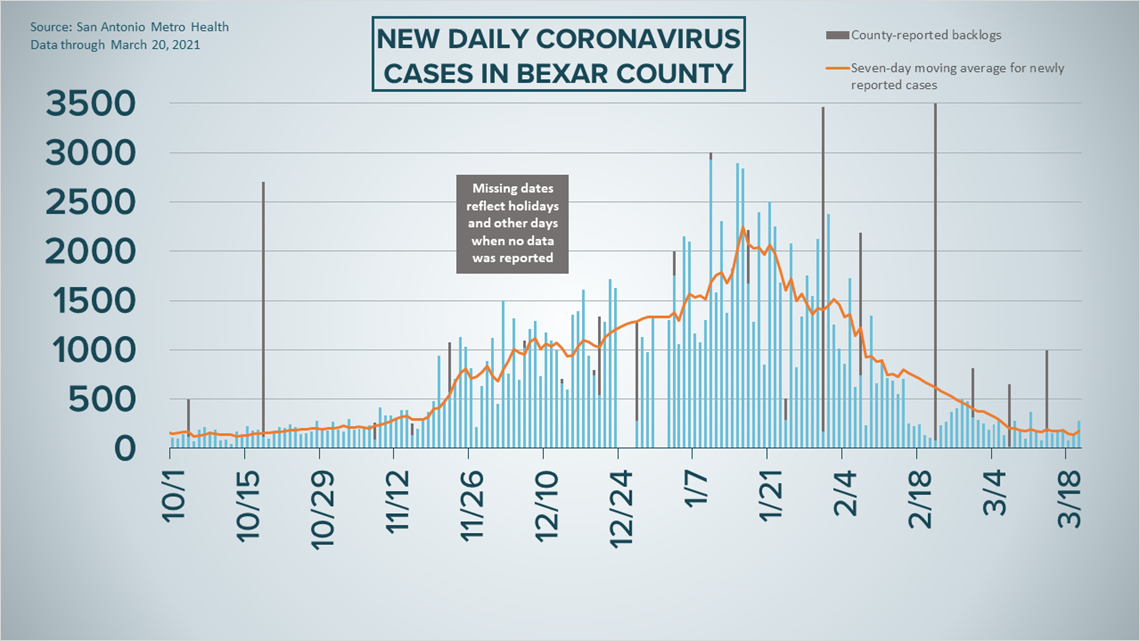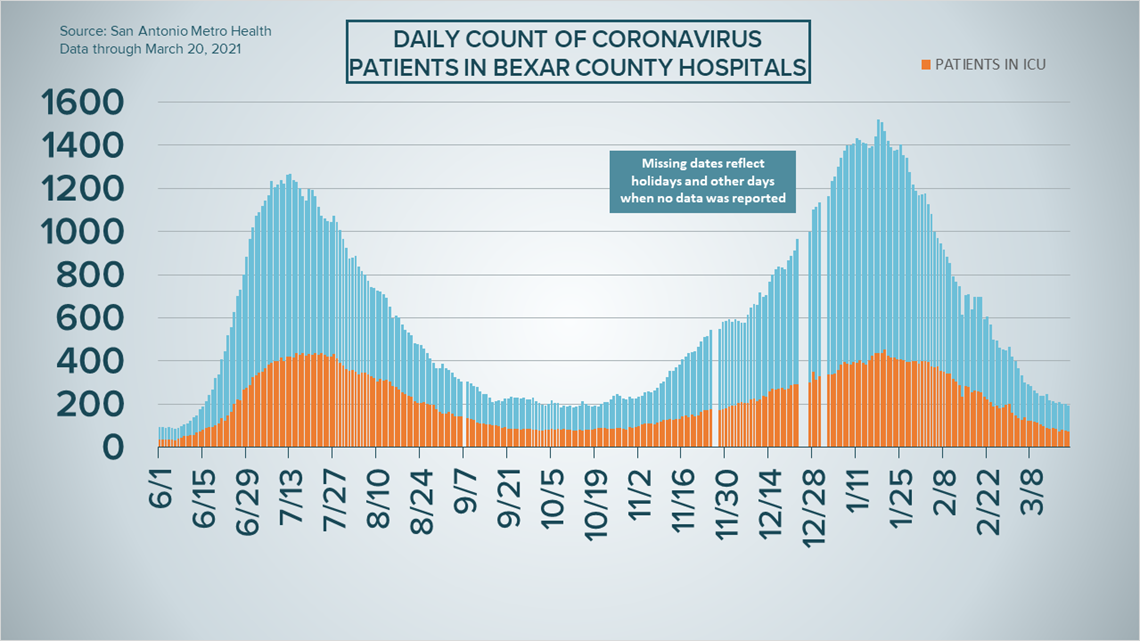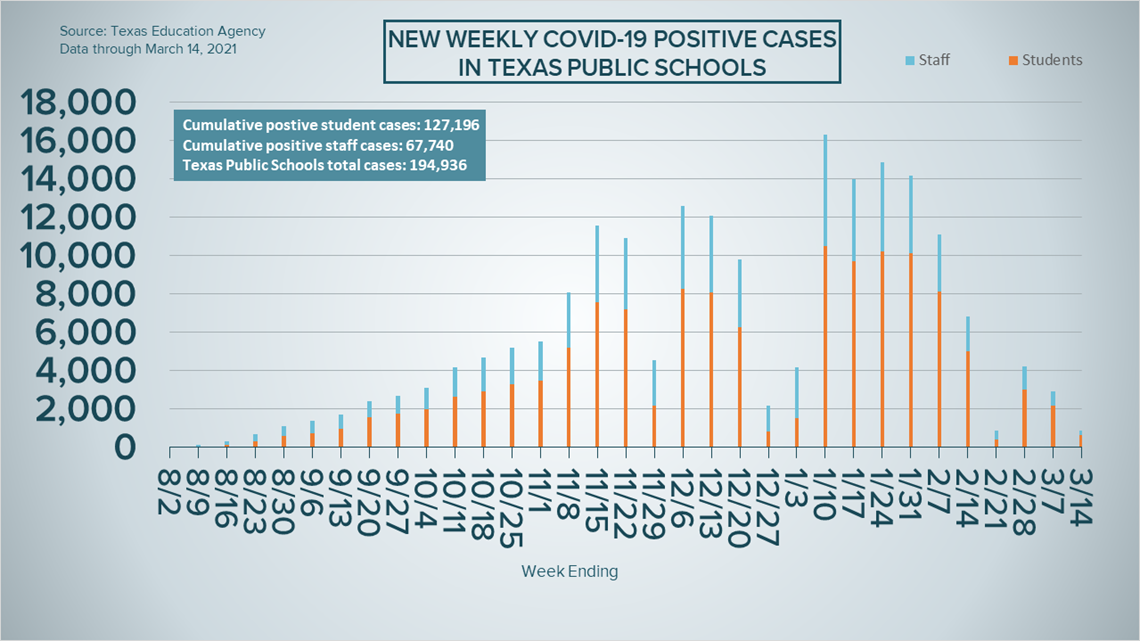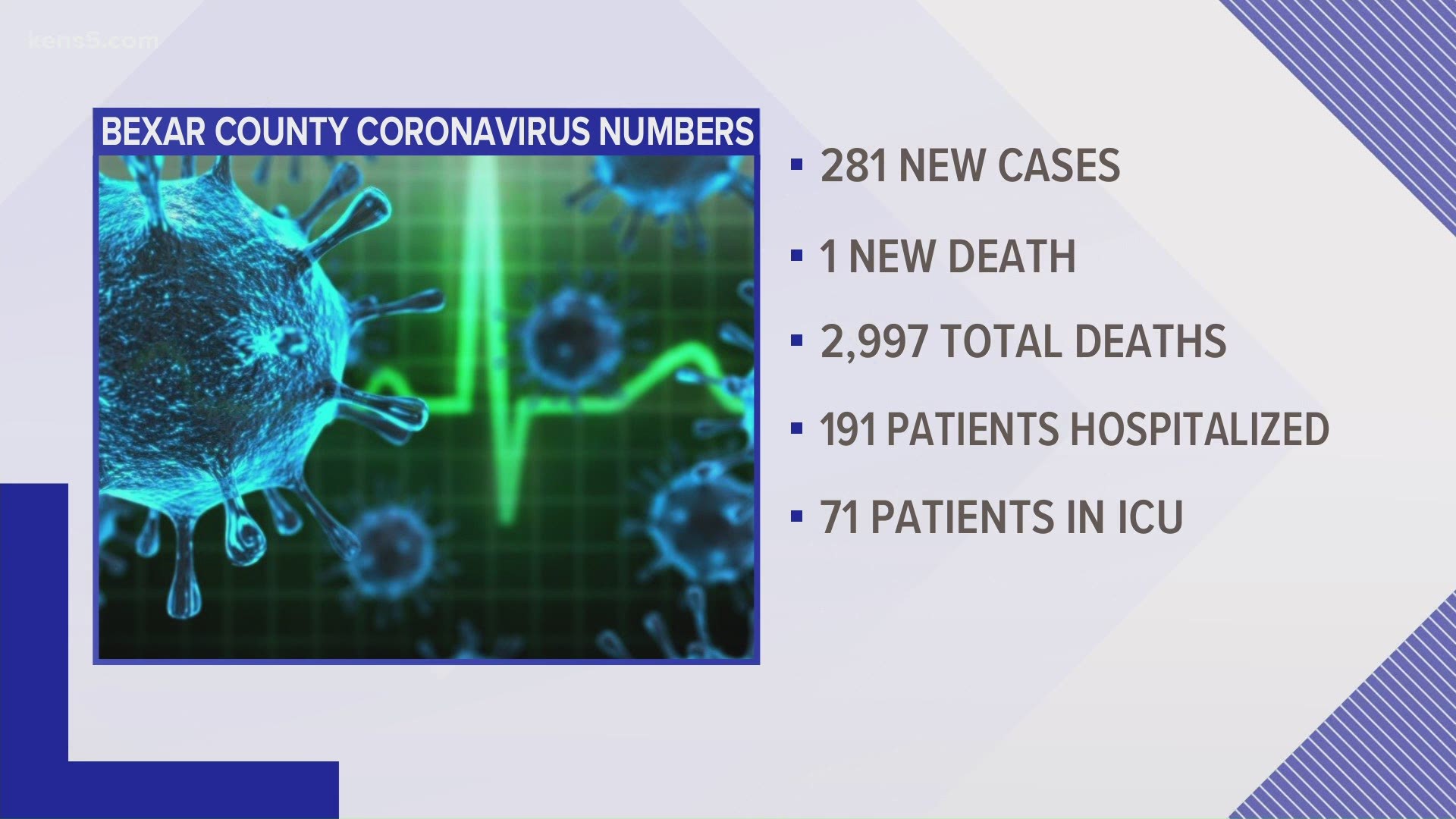SAN ANTONIO — We're tracking the latest numbers from the coronavirus pandemic in San Antonio and across Texas. Here are the latest numbers reported by Bexar and surrounding counties:
- Bexar County: On Saturday, 281 new cases were reported, bringing the total number of cases to 201,692. One new death was also reported; the local death toll from virus complications rose to 2,997.
- Hays County: On Friday, officials reported 21 new cases in the county and one additional COVID-related fatality. There is now a total of 16,877 lab-confirmed local cases, while the death toll rose to 235. Officials estimate 16,221 residents have recovered, while 421 are still ill with the virus.
- Comal County: Officials reported 17 new cases on Friday, along with no additional virus-related deaths. As of Friday, 9,512 total COVID-19 cases have been reported, including 5,009 confirmed and 4,482 probable cases, while 303 county residents have died due to COVID-19 complications.
More county case information is available through the Texas Department of Health Services COVID-19 dashboard.
How Bexar County is trending
We've tracked how many coronavirus cases have been confirmed in Bexar County from the time officials began reporting cases in March 2020. The graphic below shows the number of cases since June and charts those daily case numbers along a 7-day moving average to provide a more accurate picture of the overall coronavirus case curve in our area and the direction we're trending amid the pandemic.
On Saturday, Metro Health updated its online coronavirus dashboards to reflect an additional 281 cases in Bexar County—the most since 318 cases were reported on Feb. 28. The seven-day rolling case average jumped to 171 with the higher tally.
Health authorities also reported one new virus-related fatality. In all, 2,997 Bexar County residents have died from coronavirus complications.


Meanwhile, as of Saturday there are fewer than 200 coronavirus hospitalizations for the first time since Oct. 20; the figure stands at 191. Of those, 41 are on ventilators and 71 are in intensive care.
The number of patients in ICU hasn't been that low since the 2020 summer surge.


Coronavirus in Texas
The total number of novel coronavirus cases in the state since the pandemic began grew by 3,794 on Saturday, according to the Texas Department of State Health Services. That total includes 2,428 new confirmed cases, 1,245 new probable cases, and a backlog of 121 cases. More details can be found on this page.
Saturday's figures bring the total number of Texans diagnosed with COVID-19 to more than 2.743 million.


Meanwhile, state health authorities reported an additional 119 deaths from coronavirus complications in Texas. In all, 46,354 Texans have died from COVID-19 complications.
The number of concurrent hospitalizations across the state decreased for the eleventh day in a row, this time by 132 to 3,620 COVID-19 patients receiving treatment for their symptoms across the state, as of Saturday. The last time the figure was this low was Oct. 9.
The state, meanwhile, estimates that about 2.586 million Texans have recovered, while 106,578 Texans remain ill with COVID-19.
The latest update from the Texas Education Agency showed that there have been at least 194,936 cumulative cases among staff and students on Texas public school campuses through March 14. That number comprises 127,196 positive student cases and 67,740 staff cases. More information can be found here.


The TEA typically releases new data on school cases on Fridays.
Latest Coronavirus Headlines
- White House Easter Egg roll canceled again, official 2021 designs revealed
- Inside San Antonio's effort to vaccinate the homeless population
- Answering your vaccine questions
- US hits Biden's goal of 100 million COVID shots 42 days ahead of schedule
- Scientist behind coronavirus shot says next target is cancer
- Vaccinated pregnant woman gives birth to baby with COVID antibodies | Connect the Dots
- Half of UK adults have received first dose of COVID-19 vaccine
- Spectators from abroad barred from Tokyo Summer Olympics
- Verify: Planes, not grocery stores or restaurants, are safer in regard to COVID
Coronavirus symptoms
The symptoms of coronavirus can be similar to the flu or a bad cold. Symptoms include fever or chills, cough, shortness of breath or difficulty breathing, fatigue, muscle or body aches, headache, new loss of taste or smell sore throat, congestion or runny nose, nausea or vomiting, and diarrhea, according to the Centers for Disease Control.
Most healthy people will have mild symptoms. A study of more than 72,000 patients by the Centers for Disease Control in China showed 80 percent of the cases there were mild.
But infections can cause pneumonia, severe acute respiratory syndrome, kidney failure, and even death, according to the World Health Organization. Older people with underlying health conditions are most at risk.
Experts determined there was consistent evidence these conditions increase a person's risk, regardless of age:
- Chronic kidney disease
- COPD (chronic obstructive pulmonary disease)
- Obesity (BMI of 30 or higher)
- Immunocompromised state (weakened immune system) from solid organ transplant
- Serious heart conditions, such as heart failure, coronary artery disease, or cardiomyopathies
- Sickle cell disease
- Type 2 diabetes
- The CDC believes symptoms may appear anywhere from two to 14 days after being exposed.
Human coronaviruses are usually spread...
- Between people who are in close contact with one another (within about 6 feet).
- Through respiratory droplets produced when an infected person coughs, sneezes or talks. These droplets can land in the mouths or noses of people who are nearby or possibly be inhaled into the lungs.
- Some recent studies have suggested that COVID-19 may be spread by people who are not showing symptoms.
Help stop the spread of coronavirus
- Stay home when you are sick.
- Eat and sleep separately from your family members
- Use different utensils and dishes
- Cover your cough or sneeze with your arm, not your hand.
- If you use a tissue, throw it in the trash.
Find a Testing Location
City officials recommend getting a COVID-19 test if you experience fever or chills, cough, shortness of breath or difficulty breathing, fatigue, muscle or body aches, headache, new loss of taste or smell, sore throat, congestion or runny nose, nausea or vomiting, or diarrhea.
Here's a Testing Sites Locator to help you find the testing location closest to you in San Antonio.

